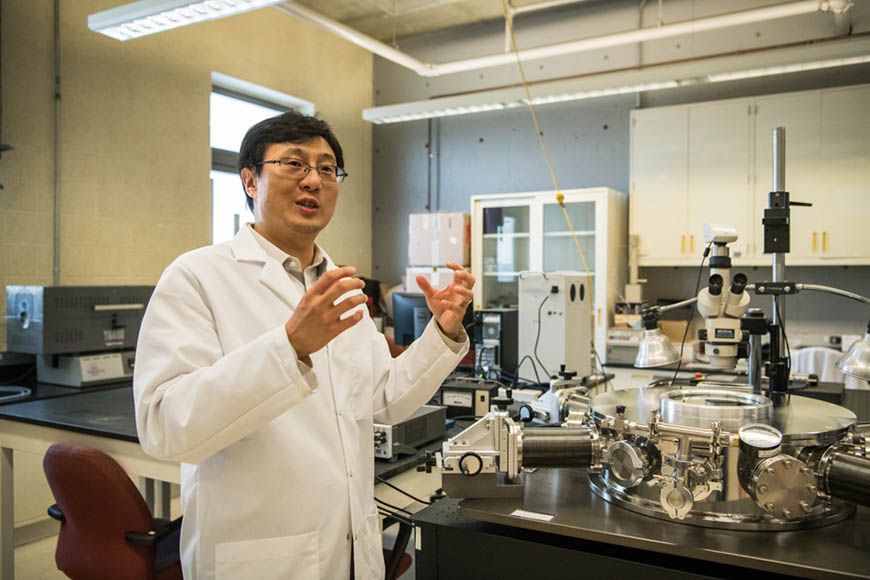New Facility Gives Villanova Leading Edge in Nano-Manufacturing

Bo Li, PhD
Some of the biggest ideas in the College of Engineering are being pursued in a facility dedicated to the world’s smallest materials. Established in 2017, the Nano-Manufacturing Lab is providing faculty and students from Villanova, Bryn Mawr College and the University of Pennsylvania with the technology needed to transform countless industries, from healthcare and agriculture to defense. Integrating advanced nanomaterials synthesis, manufacturing of nanostructures, and the latest mechanical-electrical measurement platform, the College’s newest facility is enabling frontline research in mechanical engineering, materials science, thermal science and more. The goal, says Assistant Professor of Mechanical Engineering Bo Li, PhD, is to “realize a state-of-art capability to engineer nanomaterials and nanostructures, and push nanomaterials toward real applications.”
The vision for this cutting-edge facility began more than five years ago with a National Science Foundation grant proposal for the acquisition of an atomic layer deposition device (ALD) for nanoscale materials development research. Under the leadership of former Mechanical Engineering Professor and Department Chair Amy Fleischer, PhD, (now the dean of Cal Poly’s College of Engineering), in 2014, the College was awarded a $412,106 major research instrumentation grant from the NSF to secure the Veeco/Cambridge NanoTech (CNT) Fiji G2 plasma-enhanced atomic layer deposition (PEALD) system with in-situ JA Woollam M2000D ellipsometry. The in-situ ellipsometry allows the user to characterize the thickness and optical properties of the coating during the ALD process. “According to Veeco, Villanova is one of only a few universities in the country to have the Fiji G2 PEALD with in-situ ellipsometry,” boasts Gang Feng, PhD, associate professor of Mechanical Engineering and co-PI on the project. The others include Yale and the University of Nebraska.
In addition to the in-situ PEALD, the facility also houses a chemical vapor deposition system for growth of nanomaterials and materials treatments; an electrical measurement platform; a Meso Scale Under Microscope Universal Load Frame for mechanical measurements of meso scale samples from ultrathin film to bulk materials, large range and high resolution and different deformation mode; and a nano-processing platform for nanomaterials dispersion and exfoliation, and high accuracy balance.
Recognizing that the technology reads as a foreign language for those unfamiliar with the discipline, Dr. Li prefers to focus on the research being conducted in this well-equipped space. For his part, “The big idea is to tackle the grand challenge in flexible electronics systems—understanding the heterogeneous interface between the organic substrate—the human body/skin/organs—and inorganic nanomaterials—the ceramic or metal found in electronic devices.” With advances in technology, he hopes to identify and grow better materials and structures with the appropriate electrical and mechanical responses for future flexible electronics that can literally bend and stretch to allow for an intimate connection with the human body. Health monitoring systems (i.e, wearable sensors like smart watches) are one of the obvious applications for the technology.
Composite systems are another area where the Nano-Manufacturing Lab’s technology can spur advances. Specifically, research is being conducted on the interface between nanomaterials and polymers. Dr. Li explains that nanomaterials are added to polymer systems to enhance the composite’s functionality, but given their significant expense, “the goal is to add as little as possible while realizing a huge improvement in functionality.”
While researchers across the globe are working in this area, Dr. Li says that Villanova, with its new facility, has a distinct advantage: “We have a unique capability to control the manufacturing process to ensure the proper position and thickness of a single layer of nanomaterial within a composite matrix.” A process that was previously based on trial and error can now be controlled. “We can say we want this material with this strength and this conductivity and then design and fabricate it without first expending tremendous material and financial resources to get it right.”
Along with flexible electronics and composite systems, the nano-manufacturing facility offers opportunities in the thermal sciences. Several Villanova Engineering faculty, including Dr. Feng and Associate Professor of Mechanical Engineering Calvin Li, PhD, have expertise in this area, and the potential to manufacture materials for energy-storage systems presents great possibilities. PhD students are working with Dr. Feng on two separate projects: one to enhance nanostructured phase change materials for energy-storage studies and applications; the other to develop new heat spreading materials using micro encapsulated phase change materials bound together using ALD. Dr. Calvin Li’s doctoral student is using the PEALD to enhance nanostructured metallic surfaces for two-phase change heat transfer enhancement. Finally, in yet another application for the technology, Dr. Feng is advising a project to enhance nanoparticle assemblies for optical studies and applications.
In addition to the research, the new facility will allow this state-of-the-art technology to be integrated into Villanova Engineering courses, including Manufacturing Engineering, a required course for juniors, and Nano and Microscale Materials Behavior, a graduate-level course.
Dr. Feng says, “Villanova’s unique in-situ PEALD system will have a significant effect on the disciplines of mechanical engineering, chemical engineering, materials science and physics. It will also play a major role in our ability to recruit the highest caliber PhD students and faculty. This technology will go a long way toward furthering Villanova’s reputation as both a teaching and research institution.”
